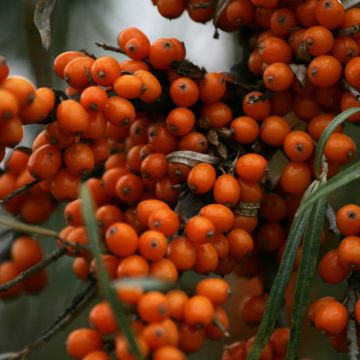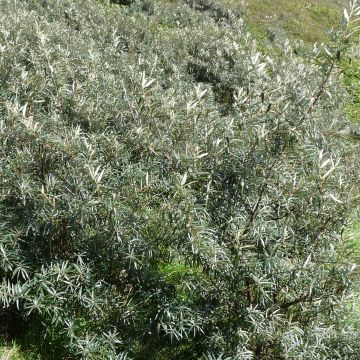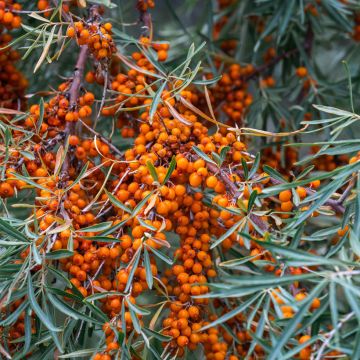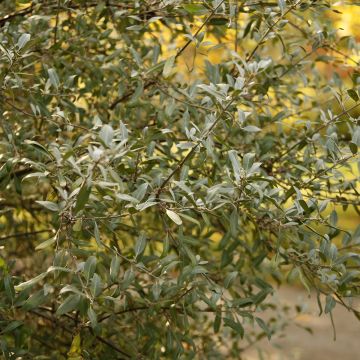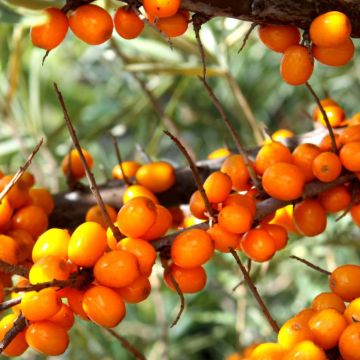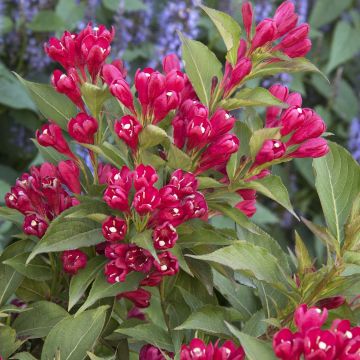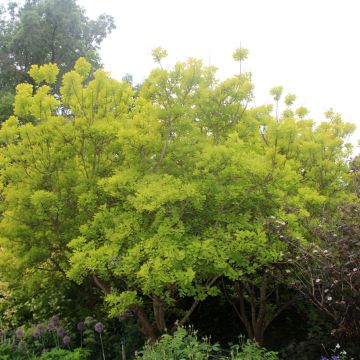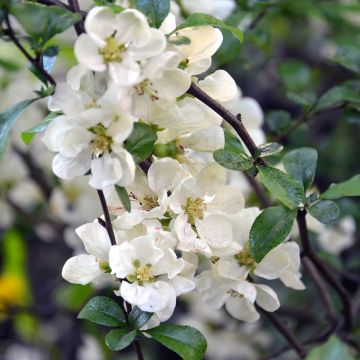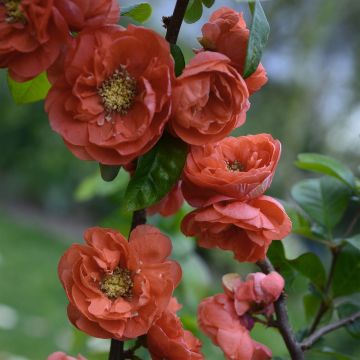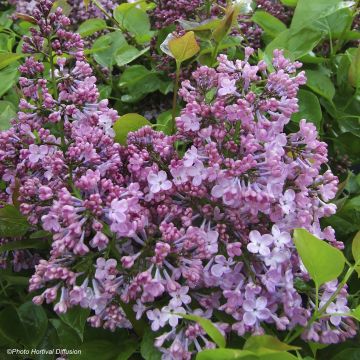

Hippophae rhamnoides Garden's Gift
Hippophae rhamnoides Garden's Gift
Hippophae rhamnoides Garden's Gift
Sea Buckthorn
Special offer!
Receive a €20 voucher for any order over €90 (excluding delivery costs, credit notes, and plastic-free options)!
1- Add your favorite plants to your cart.
2- Once you have reached €90, confirm your order (you can even choose the delivery date!).
3- As soon as your order is shipped, you will receive an email containing your voucher code, valid for 3 months (90 days).
Your voucher is unique and can only be used once, for any order with a minimum value of €20, excluding delivery costs.
Can be combined with other current offers, non-divisible and non-refundable.
Why not try an alternative variety in stock?
View all →This plant carries a 6 months recovery warranty
More information
We guarantee the quality of our plants for a full growing cycle, and will replace at our expense any plant that fails to recover under normal climatic and planting conditions.

Description
The Hippophae rhamnoides 'Garden's Gift' is a variety of sea buckthorn that produces very large dark orange fruits. Their flavour is much more pleasant and less acidic than berries from classic German selections. This highly productive variety can be harvested from September onwards. The berries should be soft before being consumed, fresh or cooked in jam, syrup or juice. They are rich in vitamins C, A and E, carotenoids, flavonoids and oil. These berries are also decorative and persist until winter if not harvested. Undemanding and hardy, this moderately spiny bushy shrub is perfect in a free, edible or defensive hedge, not far from a male variety such as 'Pollmix'.
From the Elaeagnaceae family, whose most well-known representative is undoubtedly the Elaeagnus, the Hippophae rhamnoides is the most widespread genus species known as Sea Buckthorn, Thorny Willow or Siberian Olive. This pioneer plant is native to temperate areas of Europe and Asia, where it grows in mountainous regions or on coastal dunes. The 'Garden's Gift' variety is a recent Swiss creation that stands out for its very large dark orange fruits, which are much more enjoyable to eat fresh than older varieties. Although some self-fertile varieties exist, sea buckthorn is a dioecious plant, meaning it bears either male or female flowers. Insects and wind carry out pollination. One male plant is needed for every 6 to 8 female plants to ensure good pollination and a good harvest. The female varieties produce the berries, like 'Garden's Gift'.
This bushy shrub can reach 2 to 3 m in all directions. Its trailing and graceful branches bear delicate leaves, 2 to 8 cm long, greyish-green with a silvery-white underside. They are spiny in the upper part. The spring flowers (March-April) are insignificant and adorn the pendulous branches. Once fertilized, they develop into oval berries about 1 cm in diameter, creating a cascade of orange. These berries are both decorative and edible. Very rich in vitamin C (about 30 times more than an orange), they can be eaten raw once fully ripe, usually from September onwards, or transformed into juice, jams or syrups.
This highly decorative shrub will find its place in the garden in winter, thanks to its colourful fruiting, either as a standalone plant or in a flower bed. Its edible fruits can also easily be placed in the orchard. Each plant can produce up to 20 kg of fruit. But it is in a hedge that sea buckthorns are most at home: free hedges, edible hedges, or even defensive hedges with short thorns. In an edible hedge, for example, combine it with a male Cornelian Cherry (Cornus mas) with its early yellow flowering and the 'Smoky' Amelanchier with its sumptuous autumn colours of red, orange and purple. Sea buckthorn is ideally suited for permaculture and is a natural refuge for biodiversity, beneficial to bees (melliferous flowering), birds and small mammals that love its many fruits.
Report an error about the product description
Plant habit
Fruit
Flowering
Foliage
Botanical data
Hippophae
rhamnoides
Garden's Gift
Eleagnaceae
Sea Buckthorn
Cultivar or hybrid
Other Hippophae
View all →Planting and care
The Hippophae rhamnoides 'Garden's Gift' is preferably planted in the sun or possibly in partial shade in warmer climates. Not demanding, the sea buckthorn adapts to all types of well-drained soils and will even thrive in poor soils. Hardy, not very susceptible to diseases and pests, sea buckthorn does not require any special care. It tolerates heat and drought once deeply rooted. Water it during the first years in case of dry summers. It can fix atmospheric nitrogen thanks to nodules carrying nitrogen-fixing bacteria that develop on its roots. It is sometimes used to maintain banks and fight against soil erosion.
Pruning is unnecessary, but it promotes new shoots and limits its growth if necessary. It is essential to know that berries form on two-year-old branches.
Planting period
Intended location
Care
This item has not been reviewed yet - be the first to leave a review about it.
Similar products
Haven't found what you were looking for?
Hardiness is the lowest winter temperature a plant can endure without suffering serious damage or even dying. However, hardiness is affected by location (a sheltered area, such as a patio), protection (winter cover) and soil type (hardiness is improved by well-drained soil).

Photo Sharing Terms & Conditions
In order to encourage gardeners to interact and share their experiences, Promesse de fleurs offers various media enabling content to be uploaded onto its Site - in particular via the ‘Photo sharing’ module.
The User agrees to refrain from:
- Posting any content that is illegal, prejudicial, insulting, racist, inciteful to hatred, revisionist, contrary to public decency, that infringes on privacy or on the privacy rights of third parties, in particular the publicity rights of persons and goods, intellectual property rights, or the right to privacy.
- Submitting content on behalf of a third party;
- Impersonate the identity of a third party and/or publish any personal information about a third party;
In general, the User undertakes to refrain from any unethical behaviour.
All Content (in particular text, comments, files, images, photos, videos, creative works, etc.), which may be subject to property or intellectual property rights, image or other private rights, shall remain the property of the User, subject to the limited rights granted by the terms of the licence granted by Promesse de fleurs as stated below. Users are at liberty to publish or not to publish such Content on the Site, notably via the ‘Photo Sharing’ facility, and accept that this Content shall be made public and freely accessible, notably on the Internet.
Users further acknowledge, undertake to have ,and guarantee that they hold all necessary rights and permissions to publish such material on the Site, in particular with regard to the legislation in force pertaining to any privacy, property, intellectual property, image, or contractual rights, or rights of any other nature. By publishing such Content on the Site, Users acknowledge accepting full liability as publishers of the Content within the meaning of the law, and grant Promesse de fleurs, free of charge, an inclusive, worldwide licence for the said Content for the entire duration of its publication, including all reproduction, representation, up/downloading, displaying, performing, transmission, and storage rights.
Users also grant permission for their name to be linked to the Content and accept that this link may not always be made available.
By engaging in posting material, Users consent to their Content becoming automatically accessible on the Internet, in particular on other sites and/or blogs and/or web pages of the Promesse de fleurs site, including in particular social pages and the Promesse de fleurs catalogue.
Users may secure the removal of entrusted content free of charge by issuing a simple request via our contact form.
The flowering period indicated on our website applies to countries and regions located in USDA zone 8 (France, the United Kingdom, Ireland, the Netherlands, etc.)
It will vary according to where you live:
- In zones 9 to 10 (Italy, Spain, Greece, etc.), flowering will occur about 2 to 4 weeks earlier.
- In zones 6 to 7 (Germany, Poland, Slovenia, and lower mountainous regions), flowering will be delayed by 2 to 3 weeks.
- In zone 5 (Central Europe, Scandinavia), blooming will be delayed by 3 to 5 weeks.
In temperate climates, pruning of spring-flowering shrubs (forsythia, spireas, etc.) should be done just after flowering.
Pruning of summer-flowering shrubs (Indian Lilac, Perovskia, etc.) can be done in winter or spring.
In cold regions as well as with frost-sensitive plants, avoid pruning too early when severe frosts may still occur.
The planting period indicated on our website applies to countries and regions located in USDA zone 8 (France, United Kingdom, Ireland, Netherlands).
It will vary according to where you live:
- In Mediterranean zones (Marseille, Madrid, Milan, etc.), autumn and winter are the best planting periods.
- In continental zones (Strasbourg, Munich, Vienna, etc.), delay planting by 2 to 3 weeks in spring and bring it forward by 2 to 4 weeks in autumn.
- In mountainous regions (the Alps, Pyrenees, Carpathians, etc.), it is best to plant in late spring (May-June) or late summer (August-September).
The harvesting period indicated on our website applies to countries and regions in USDA zone 8 (France, England, Ireland, the Netherlands).
In colder areas (Scandinavia, Poland, Austria...) fruit and vegetable harvests are likely to be delayed by 3-4 weeks.
In warmer areas (Italy, Spain, Greece, etc.), harvesting will probably take place earlier, depending on weather conditions.
The sowing periods indicated on our website apply to countries and regions within USDA Zone 8 (France, UK, Ireland, Netherlands).
In colder areas (Scandinavia, Poland, Austria...), delay any outdoor sowing by 3-4 weeks, or sow under glass.
In warmer climes (Italy, Spain, Greece, etc.), bring outdoor sowing forward by a few weeks.






























